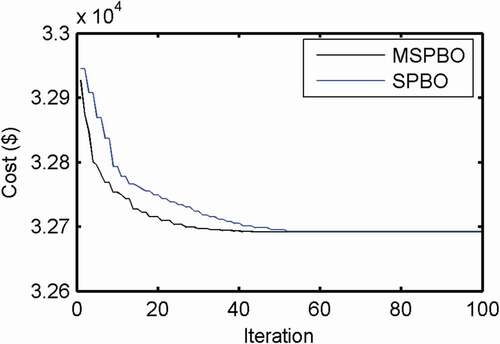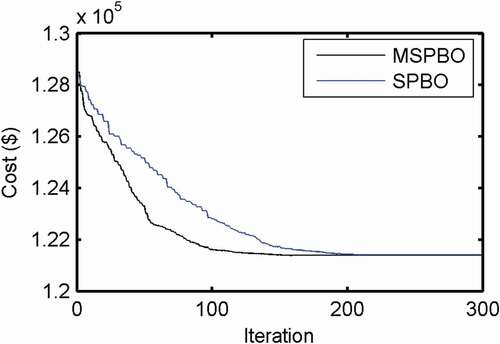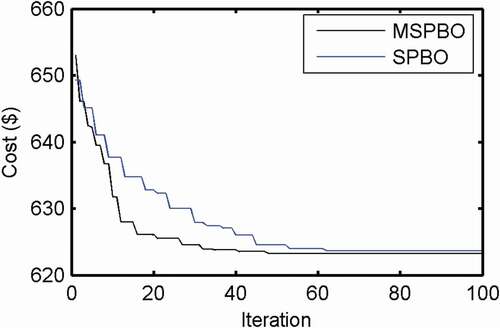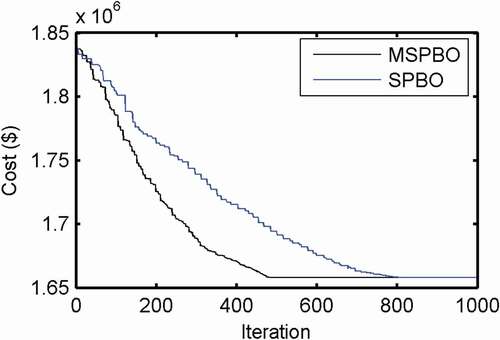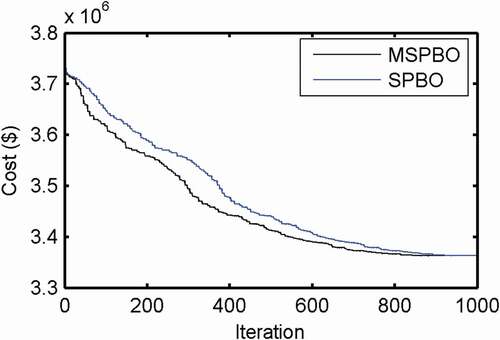 ?Mathematical formulae have been encoded as MathML and are displayed in this HTML version using MathJax in order to improve their display. Uncheck the box to turn MathJax off. This feature requires Javascript. Click on a formula to zoom.
?Mathematical formulae have been encoded as MathML and are displayed in this HTML version using MathJax in order to improve their display. Uncheck the box to turn MathJax off. This feature requires Javascript. Click on a formula to zoom.ABSTRACT
This manuscript develops and suggests modified student psychology-based optimization (MSPBO) algorithm to the convoluted economic dispatch problem. The psychology of the students who provide more attempts to perk up their recital in the exam equal to the echelon for turn out to be the best student in the class forms the basis of student psychology-based optimization (SPBO) algorithm. In this manuscript, MSPBO has been suggested to improve convergence speed and better-quality solutions. The efficacy of MSPBO algorithm has been divulged on five different economic dispatch problems incorporating valve-point consequence, proscribed feasible area, ramp rate borders, and manifold fuels. Simulation outcomes of the recommended method are matched up toward those attained as of other affirmed artificial intelligence methods. It is viewed from the assessment that suggested MSPBO is capable of giving better results.
Introduction
Economic dispatch (ED) provides generation among all committed generating units mainly economically simultaneously rewarding various restrictions. Valve-point consequence [3] is epitomized by summing up sinusoidal and quadratic functions.
Because of the opening of the steam admission valve, shaft posture shiver produces a proscribed workable area [6] in some sections of the generation region. The optimum cost is attained by evading this feasible area.
Traditional methods are not able to resolve ED problems with such types of complexity. Dynamic programming is able to resolve such types of complications, however, it experiences dimensionality crisis as well as confined optimality.
Preface of artificial intelligence techniques has given choices to resolve these types of complicated ED for example particle swarm optimization (PSO) by Gaing (Citation2003) and Park et al. (Citation2005), Tabu search (TS) by Whei-Min, Fu-Sheng, and Ming-Tong (Citation2002), genetic algorithm (GA) by Walter and Sheble (Citation1993), Cheng and Chang (Citation1995) and Chiang (Citation2005), evolutionary strategy by Pereira-Neto, Unsihuary, and Saavedra (Citation2005), evolutionary programming (EP) by Yang, Yang, and Huang (Citation1996) and Sinha, Chakrabarti, and Chattopadhyay (Citation2003), chaotic differential evolution (CDE) by Coelho Leandro dos and Mariani (Citation2006), new particle swarm optimization by Selvakumar and Thanushkodi (Citation2007), civilized swarm optimization by Selvakumar and Thanushkodi (Citation2009), improved particle swarm optimization by Park et al. (Citation2010), biogeography-based optimization (BBO) by Bhattacharya and Chattopadhyay Citation2010a), hybrid differential evolution with biogeography-based optimization Bhattacharya and Chattopadhyay Citation2010a), ant colony optimization (ACO) by Pothiya, Ngamroo, and Kongprawechnon (Citation2010), cultural self-organizing migrating strategy by Coelho Leandro dos and Mariani (Citation2010), artificial bee colony algorithm (ABC) by Hemamalini and Simon (Citation2010), continuous quick group search optimizer by Moradi-Dalvand et al. (Citation2012), differential evolution based on truncated Levy-type flights and population diversity measure by Coelho Leandro dos, Bora, and Mariani (Citation2014), oppositional invasive weed optimization by Braisal and Prusty (Citation2015), crisscross optimization by Meng, Li, and Yin (Citation2016), backtracking search algorithm by Modiri-Delshad et al. (Citation2016), hybrid gray wolf optimize (HGWO) by Jayabarathi et al. (Citation2016), modified symbiotic Organisms search (SOS) algorithm by Calin (Citation2016), fast convergence evolutionary programming (FCEP) by Basu (Citation2017), hybrid artificial algae (HAA) algorithm by Kumar and Dhillon (Citation2018), modified crow search algorithm (MCSA) by Mohammadi and Abdi (Citation2018), ameliorated gray wolf optimization (AGWO) by Singh and Dhillon (Citation2019), conglomerated optimizer based on ion-motion and crisscross search optimizers (C-MIMO–CSO) by Kumar and Dhillon (Citation2019), crow search algorithm (CSA) by Spea Shaimaa (Citation2020), squirrel search optimizer (SSO) by Sumanl, Sakthivel, and Sathya (Citation2020), emended salp swarm algorithm (ESSA) by Kansal and Dhillon (Citation2020), dual-population adaptive differential evolution (DPADE) algorithm by Chen (Citation2020), squirrel search algorithm (SSA) by Sakthivel, Suman, and Sathya (Citation2020), etc.
In very recent times, Das, Mukherjee, and Das (Citation2020) have developed a student psychology-based optimization (SPBO) algorithm, which is rooted in the psychology of the student who tries to acquire good marks in the exam.
In this manuscript, modified student psychology-based optimization (MSPBO) algorithm has been suggested for improving convergence speed and better-quality solutions.
In this manuscript, MSPBO and SPBO have been used for solving convoluted ED problems. Simulation outcomes of the suggested MSPBO algorithm are compared with those attained from other avowed artificial intelligence methods. It is viewed that the suggested MSPBO algorithm provides improved results.
Problem formulation
ED minimizes the fuel cost of power generation plants at the same time fulfilling several constraints. ED gets valve-point consequence, proscribed feasible area, ramp rate borders, as well as manifold fuels together with power demand, transmission losses, plus operational capability frontiers.
Economic dispatch Incorporating quadratic cost function, proscribed feasible area, ramp rate borders, and transmission losses
Economic dispatch is avowed as:
Min
where ,
, and
are the cost coefficients of the
th generator,
is the power output of the
th generator, and
is the total number of generators.
Subject to the constraints
(i) Power equilibrium constraint
The transmission loss is avowed as
where is load demand and
,
, and
are the
-coefficients.
(ii) Generation capacity boundary constraints
The output power of the generator should lie inside its minimum and maximum boundaries.
where is the minimum boundary and
is the maximum boundary of the
th generator.
(iii) Proscribed feasible county
Workable region of a generator with the forbidden feasible county is stated as:
where denotes the number of the forbidden feasible county of the
th generator.
is the maximum boundary of
th the forbidden feasible county, and
is the minimum boundary of the
th forbidden feasible county. The total number of forbidden feasible county of the
th generator is
.
(Iv) Ramp rate frontier constraints
Power , generated by
th generator in a specific period must neither go further than that of the previous period
by above a specific amount
, ramp-up boundary nor lower than that of the previous period by above a definite amount
, the ramp-down boundary of the
th generator. These produce the following constraints.
As generation enhances
As generation reduces
and
Economic dispatch incorporating valve-point consequence
Economic dispatch subject to constraints bestowed by EquationEquations (2)(2)
(2) and (Equation4
(4)
(4) ) is avowed as:
Min
where and
are the cost coefficients of the
th generator due to valve point consequence.
Economic dispatch incorporating valve-point consequence and manifold fuels
A generator is normally proffered by manifold fuels, epitomized by several piecewise quadratic functions permit for valve point consequence. Cost function of the th generator with
fuel categories are avowed as
if for fuel type
and
where and
are the lower and upper power borders of
th generator for
th fuel category, respectively.
,
,
,
, and
are cost coefficients of the
th generator for fuel category
.
The objective function subject to constraints bestowed by EquationEquations (2)(2)
(2) and (Equation4
(4)
(4) ) is avowed as:
Min
Calculation of relaxed generator
dedicated generators allocate their output power subject to power equilibrium constraint (2) as well as power capability constraints (4). If power loading of first (
) generators have been identified, power output of
th generator (i.e. relaxed generator) is provided by
Devoid of transmission loss
Pondering transmission loss
Transmission loss is provided by
Augmenting and reshuffling, EquationEquation (13)(13)
(13) turns into
Loading of the relaxed generator (i.e. th) is established by resolving EquationEquation (15)
(15)
(15) utilizing the classical algebraic technique.
For fulfilling equality constraint (13), the positive root of (15) has been selected as the power output of th generating unit.
If positive root breaches operational boundary constraint (4) at initialization procedure, then the power output of first generators has been reinitialized until positive root fulfills operational boundary constraint (4).
If positive root breaches operational boundary constraint (4) at a later phase of the method, then that customized generation is eliminated, and different steps of the method have been reapplied on its previous value until constraint (4) is fulfilled.
Student psychology based optimization algorithm
Student psychology-based optimization algorithm developed by Das, Mukherjee, and Das (Citation2020) is founded on the psychology of the student who is endeavoring to acquire the best marks in the exam. The recital of a student is determined by considering the marks acquired in the exam. The student acquiring the highest marks in the exam is regarded as the best student in the class. Generally, the student endeavors to improve the recital so that the student can become the best student in the class. For achieving this goal, students must provide more attempts to all subjects proffered to them. However, the attempt provided by any student to any subject hinges on the student’s ability, adeptness in addition to interest in that subject. So, it is observed that the enhancement of recital in the exam of all students is not identical and can be different from student to student. A few students endeavor to perk up recital by providing identical or superior sort of attempts provided by the best student. Simultaneously, a number of students endeavor to provide attempts taking into consideration the attempt provided by the best student and endeavor to provide more attempts than the attempts provided by the average students in the class. Therefore, the students of a class can be classified into four categories. These are the best students, good students, average students, and students who endeavor to perk up at random.
Classification of students
(i) Best student: The student acquiring the highest overall marks in the exam is regarded as the best student in the class who all the time endeavors for providing more attempt to all subjects than the attempts provided by the rest of the students to keep up the best position by acquiring the highest marks in the class. Enhancement of the best student is stated as follows.
where and
are the marks acquired by the best student and randomly selected
th student, respectively, in a particular subject,
is a random number in between 0 and 1, and k is a randomly chosen parameter either 1 or 2.
(ii) Good student: The student endeavors to provide increasingly attempt at any subject in which he gets interest for enhancing the recital in general. This type of student is selected randomly as the difference of psychology of the students and is regarded as the subject wise good student. To be the best student in the class by acquiring the highest marks in the exam, few students endeavor to provide identical or superior sort of attempt provided by the best student. This class of students is signified using EquationEquation (17)(17)
(17) . Simultaneously, a number of students endeavor to provide more attempts in the study than the attempt provided by the average students of the class and endeavor to pursue the attempt provided by the best student. This class of students is signified using EquationEquation (18)
(18)
(18) .
where is the marks acquired by the
th student in a particular subject,
is the average recital of the class in that particular subject, and
is a random number in between 0 and 1.
(iii) Average student: Since the attempt provided by a student hinges on the interest of the student in the offered subjects, the students proffer an average attempt to the subject which is less interested to him. Whilst providing an average attempt to that subject, the students endeavor to provide more attempts to other subjects so that their overall marks are perked up. This class of students is referred to as the subject-wise average student. Due to different students’ psychology, this class of students is chosen randomly. Recital of this class of students is signified using EquationEquation (19)(19)
(19) .
where and
are the marks acquired by the
th student and the average marks acquired by the class in that particular subject, respectively, and
is a random number in between 0 and 1.
(iv) Students who endeavor to perk up at random: Apart from these abovementioned classes of students, a number of students endeavor to perk up their recital by themselves. These students endeavor to provide attempt to the subject arbitrarily hinging on the subject. This class of students endeavors to provide attempt arbitrarily to the subject so that overall recital in the exam perks up. Recital of this class of student is signified using EquationEquation (20)(20)
(20) .
where and
are the minimum and the maximum limit of marks of the subject, respectively.
Selection
Compute recital of the class. If the new recital is better than older, then replace older by new one otherwise, keep older recital.
Modified student psychology-based optimization algorithm
In the modified student psychology-based optimization (MSPBO) algorithm, some modification is suggested in student psychology-based optimization (SPBO) algorithm to improve convergence speed and better-quality solution.
Classification of students
(i) Best student: The enhancement of the best student is modified as follows.
where and
are the marks acquired by the best student and randomly selected
th student, respectively, in a particular subject,
signifies Gaussian random variable with mean 0 and standard deviation 1.
(ii) Good student: A few students want to be the best student in the class by acquiring the highest marks in the exam and endeavor to provide identical or superior sort of attempt provided by the best student. This class of students is modified as follows:
Simultaneously, a number of students who endeavor to provide more attempts in study than the attempt provided by the average students of the class and endeavor to pursue the attempt provided by the best student are modified as follows:
where is the marks acquired by the
th student in a particular subject,
is the average recital of the class in that particular subject,
signifies Gaussian random variable with mean 0 and standard deviation 1.
(iii) Average student: Recital of the average student is modified as follows:
where and
are the marks acquired by the
th student and the average marks acquired by the class in that particular subject, respectively, and
signifies Gaussian random variable with mean 0 and standard deviation 1.
(iv) Students who endeavor to perk up at random: Apart from these aforesaid classes of students, a number of students who endeavor to perk up their recital by themselves and to provide attempt to the subject arbitrarily hinging on the subject so that overall recital in the exam perks up are modified as follows:
where and
are the minimum and the maximum limit of marks of the subject, respectively.
Selection
Compute recital of the class. If the new recital is better than older, then replace older by new one otherwise, keep older recital.
Numerical results
Modified student psychology-based optimization (MSPBO) algorithm and student psychology-based optimization (SPBO) algorithm are employed for solving ED. The suggested MSPBO and SPBO have been employed by utilizing MATLAB (Version: (R2013a)). MSPBO and SPBO have been employed to solve five different economic dispatch problems such as 15-unit system with proscribed feasible area, ramp rate borders, and transmission losses, a 40-unit system with valve point effect, a 10-unit system with manifold fuels, and valve point effect, a 140-unit convoluted Korean system, and 280-unit system. A total of 100 runs are executed for all systems to compare the resolution quality. Simulation outcomes have been used to compare the concert of MSPBO and SPBO with that of other avowed evolutionary techniques.
Test system 1
This test system includes 15 generating units with proscribed feasible area, ramp rate borders, and transmission losses. Generating units 2, 5, and 6 have three proscribed feasible areas and generating unit 12 has two proscribed feasible areas. The power demand is 2630 MW. The data is espoused from Gaing (Citation2003) and revealed in . Transmission loss coefficients are not mentioned here on account of word limitations.
Table 1. Generation constraints and best power output attained from MSPBO for test system 1 with power demand of 2630 MW
Problem is resolved by utilizing both MSPBO and SPBO. Parameters have been chosen as and
.
Power generation, power loss, and cost related to the preeminent cost among 100 runs attained from recommended MSPBO have been summed up in . Preeminent, mean, and worst costs among 100 runs attained from recommended MSPBO have been summed up in . Cost acquired from SPBO, particle swarm optimization (PSO), improved particle swarm optimization (IPSO), backtracking search algorithm (BSA), fast convergence evolutionary programming (FCEP), conglomerated optimizer based on ion-motion and crisscross search optimizers (C-MIMO–CSO), and emended salp swarm algorithm (ESSA) is also summed up in . Cost convergence characteristic achieved from MSPBO and SPBO is revealed in . It is viewed from that cost attained by utilizing MSPBO is lower than all other avowed methods.
Table 2. Cost and CPU time assessment of test system 1
Test system 2
This test system includes 40 generating units and the data is espoused from Sinha, Chakrabarti, and Chattopadhyay (Citation2003) and revealed in . Power demand is 10,500 MW.
Table 3. Generation constraints and best power output attained from MSPBO for test system 2 with power demand of 10,500 MW
Problem is resolved by utilizing both MSPBO and SPBO. Parameters have been chosen as and
.
Power generation related to the preeminent cost among 100 runs attained from MSPBO has been summed up in . Preeminent, mean, and worst costs among 100 runs attained from MSPBO have been summed up in . Cost attained from SPBO, NPSO-LRS, DEC-SQP, CSO, IPSO, BBO, DE/BBO, ACO, CSOMA, ABC, CQGSO, OIWO, HGWO, MSOS, FCEP, HAAA, MCSA, AGWO, C-MIMO–CSO, SSO, and ESSA has been also summed up in . Cost convergence characteristic achieved from MSPBO and SPBO has been revealed in . It is viewed from that cost attained by using MSPBO is lower than all other avowed methods.
Table 4. Cost and CPU time assessment of test system 2
Test system 3
This test system includes 10 generators with valve point effect and manifold fuels. Power demand is 2700 MW and data is espoused from Chiang (20005) and not mentioned here because of the word limitations.
Problem is resolved by utilizing both MSPBO and SPBO. Parameters have been chosen as and
.
Power generation related to the preeminent cost among 100 runs attained from recommended MSPBO has been summed up in . Preeminent, mean, and worst costs among 100 runs attained from recommended MSPBO have been summed up in . Cost attained from SPBO, NPSO-LRS, IPSO, CQGSO, CSO, BSA, FCEP, MCSA, C-MIMO–CSO, CSA, SSO, and DPADE has been also summed up in . Cost convergence characteristic achieved from MSPBO and SPBO has been revealed in . It is viewed from that cost attained by using MSPBO is lower than all other avowed methods.
Table 5. Generation (MW) of test system 3
Table 6. Cost and CPU time assessment of test system 3
Test system 4
This is 140 unit convoluted Korean system of 12 generators with valve point effect and four generators with proscribed feasible area. Ramp rate borders have been pondered here. Power demand is 49,342 MW. Data has been espoused from Park et al. (Citation2010)] and not mentioned here due to the word limitations.
Problem is resolved by utilizing both MSPBO and SPBO. Parameters have been chosen as and
.
Power generation related to the preeminent cost among 100 runs attained from recommended MSPBO has been summed up in . Preeminent, mean, and worst costs among 100 runs obtained from recommended MSPBO have been summarized in . Cost attained from SPBO, IPSO, CQGSO, DEL, FCEP, and AGWO have been summarized in . Cost convergence characteristic achieved from MSPBO and SPBO is revealed in . It is viewed from that cost attained by using MSPBO is lower than all other avowed methods.
Table 7. Generation (MW) of test system 4
Table 8. Cost and CPU time assessment of test system 4
Test system 5
This is a 280 unit system of 24 generators with valve point effect and eight generators with proscribed feasible area. Ramp rate borders have been pondered here. Power demand is 98,684 MW. Data of test system 5 is attained by duplicating data of test system 4.
Problem is resolved by using both MSPBO and SPBO. Parameters have been chosen as and
.
Power generations of first 140 generators of test system 5 related to the preeminent cost among 100 runs attained from MSPBO are summed up in . Power generations of last 140 generators of test system 5 related to the preeminent cost among 100 runs attained from MSPBO are summed up in . Preeminent, mean, and worst costs among 100 runs obtained from suggested MSPBO and SPBO have been summarized in . Cost convergence characteristic achieved from MSPBO and SPBO is revealed in .
Table 9. Generation (MW) of first 140 generators of test system 5
Table 10. Generation (MW) of last 140 generators of test system 5
Table 11. Cost and CPU time assessment of test system 5
Conclusion
MSPBO has been developed and employed to solve five convoluted economic dispatch problems. Simulation outcomes attained from the MSPBO and SPBO are compared with those attained from other artificial intelligence techniques. It is viewed that MSPBO offers better of solution.
Disclosure statement
No potential conflict of interest was reported by the author(s).
References
- Basu, M. 2017. Fast convergence evolutionary programming for economic dispatch problems. IET Generation, Transmission & Distribution 11 (16):4009–17. doi:https://doi.org/10.1049/iet-gtd.2017.0275.
- Bhattacharya, A., and P. K. Chattopadhyay. 2010a. Biogeography-based optimization for different economic load dispatch problems. IEEE Transactions on Power Systems 25 (2):1064–77. doi:https://doi.org/10.1109/TPWRS.2009.2034525.
- Braisal, A. K., and R. C. Prusty. 2015. Large scale economic dispatch of power systems using oppositional invasive weed optimization. Applied Soft Computing 29 (4):122–37. doi:https://doi.org/10.1016/j.asoc.2014.12.014.
- Calin, S. D. 2016. A modified symbiotic organisms search algorithm for large scale economic dispatch with valve-point effects. Energy 113:366–84. doi:https://doi.org/10.1016/j.energy.2016.07.056.
- Chen, X. 2020. Novel dual-population adaptive differential evolution algorithm for large-scale multi-fuel economic dispatch with valve-point effects. Energy 203 (117874):2–15. doi:https://doi.org/10.1016/j.energy.2020.117874.
- Cheng, P. H., and H. C. Chang. 1995. Large scale economic dispatch by genetic algorithm. IEEE Transactions on Power Systems 10, (4):1919–26. doi:https://doi.org/10.1109/59.476058.
- Chiang, C.-L. 2005. Improved genetic algorithm for power economic dispatch of units with valve-point effects and multiple fuels. IEEE Transactions on Power Systems 20 (4):1690–99. doi:https://doi.org/10.1109/TPWRS.2005.857924.
- Coelho Leandro dos, S., T. C. Bora, and V. C. Mariani. 2014. Differential evolution based on truncated Levy-type flights and population diversity measure to solve economic load dispatch problems. Electrical Power and Energy Systems 57:178–88.
- Coelho Leandro dos, S., and V. C. Mariani. 2006. Combining of chaotic differential evolution and quadratic programming for economic dispatch optimization with value-point effect. IEEE Transactions on Power Systems 21 (2):989–95. doi:https://doi.org/10.1109/TPWRS.2006.873410.
- Coelho Leandro dos, S., and V. C. Mariani. 2010. An efficient cultural self-organizing migrating strategy for economic dispatch optimization with valve-point effect. Int J Energy Convers Manag 51 (12):2580–87. doi:https://doi.org/10.1016/j.enconman.2010.05.022.
- Das, B., V. Mukherjee, and D. Das. 2020. Student psychology based optimization algorithm: A new population based optimization algorithm for solving optimization problems. Advances in Engineering Software 146:102804. doi:https://doi.org/10.1016/j.advengsoft.2020.102804.
- Gaing, Z.-L. 2003. Particle swarm optimization to solving the economic dispatch considering the generator constraints. IEEE Transactions on Power Systems 18 (3):1187–95. doi:https://doi.org/10.1109/TPWRS.2003.814889.
- Hemamalini, S., and S. P. Simon. 2010. Artificial bee colony algorithm for economic load dispatch problem with non-smooth cost functions. Electric Power Component and Systems 38 (7):786–803. doi:https://doi.org/10.1080/15325000903489710.
- Jayabarathi, T., T. Raghunathan, B. R. Adarsh, and P. N. Suganthan. 2016. Economic dispatch using hybrid grey wolf optimize. Energy 111:630–41. doi:https://doi.org/10.1016/j.energy.2016.05.105.
- Kansal, V., and J. S. Dhillon. 2020. Emended salp swarm algorithm for multiobjective electric power dispatch problem. Applied Soft Computing Journal 90 (106172):1–26. doi:https://doi.org/10.1016/j.asoc.2020.106172.
- Kumar, M., and J. S. Dhillon. 2018. Hybrid artificial algae algorithm for economic load dispatch. Applied Soft Computing 71:89–109. doi:https://doi.org/10.1016/j.asoc.2018.06.035.
- Kumar, M., and J. S. Dhillon. 2019. A conglomerated ion-motion and crisscross search optimizer for electric power load dispatch. Applied Soft Computing Journal 83 (105641):1–29. doi:https://doi.org/10.1016/j.asoc.2019.105641.
- Meng, A., J. Li, and H. Yin. 2016. An efficient crisscross optimization solution to large-scale non-convex economic load dispatch with multiple fuel types and valve-point. Energy 113:1147–61.
- Modiri-Delshad, M., K. S. Hr, T.-R. E. Aghay, and N. ABD Rahim. 2016. Backtracking search algorithm for solving economic dispatch problems with valve-point effects and multiple fuel options. Energy 116:637–49. doi:https://doi.org/10.1016/j.energy.2016.09.140.
- Mohammadi, F., and H. Abdi. 2018. A modified crow search algorithm (MCSA) for solving economic loaddispatch problem. Applied Soft Computing 71:51–65. doi:https://doi.org/10.1016/j.asoc.2018.06.040.
- Moradi-Dalvand, M., B. Mohammadi-Ivatloo, A. Najafi, and A. Rabiee. 2012. “Continuous quick group search optimizer for solving non-convex economic dispatch problems.” Electric.Power Systems Research 93:93–105. doi:https://doi.org/10.1016/j.epsr.2012.07.009.
- Park, J. B., Y. W. Jeong, J. R. Shin, and K. Y. Lee. 2010. An improved particle swarm optimization for nonconvex economic dispatch problems. IEEE Transactions on Power Systems 25 (1):156–66. doi:https://doi.org/10.1109/TPWRS.2009.2030293.
- Park, J. B., K. S. Lee, J. R. Shin, and K. Y. Lee. 2005. A particle swarm optimization for economic dispatch with nonsmooth cost function. IEEE Transactions on Power Systems 20 (1):34–42. doi:https://doi.org/10.1109/TPWRS.2004.831275.
- Pereira-Neto, A., C. Unsihuary, and O. R. Saavedra. 2005. Efficient evolutionary strategy optimization procedure to solve the nonconvex economic dispatch problem with generator constraints. IEE Proceedings Generation Transmission and Distribution 152 (5):653–60. doi:https://doi.org/10.1049/ip-gtd:20045287.
- Pothiya, S., I. Ngamroo, and W. Kongprawechnon. 2010. Ant colony optimization for economic dispatch problem with non-smooth cost functions. International Journal of Electrical Power & Energy Systems 32 (5):478–87. doi:https://doi.org/10.1016/j.ijepes.2009.09.016.
- Sakthivel, V. P., M. Suman, and P. D. Sathya. 2020. Squirrel search algorithm for economic dispatch with valve-point effects and multiple fuels. Energy Sources, Part B: Economics, Planning, and Policy 15: 6.
- Selvakumar, A. I., and K. Thanushkodi. 2007. A new particle swarm optimization solution to nonconvex economic dispatch problems. IEEE Transactions on Power Systems 22 (1):42–51. doi:https://doi.org/10.1109/TPWRS.2006.889132.
- Selvakumar, A. I., and K. Thanushkodi. 2009. Optimization using civilized swarm: Solution to economic dispatch with multiple minima. International Journal of Electrical Power & Energy Systems 79:8–16. doi:https://doi.org/10.1016/j.epsr.2008.05.001.
- Singh, D., and J. S. Dhillon. 2019. Ameliorated grey wolf optimization for economic load dispatch problem. Energy 169:398–419. doi:https://doi.org/10.1016/j.energy.2018.11.034.
- Sinha, N., R. Chakrabarti, and P. K. Chattopadhyay. 2003. Evolutionary programming techniques for economic load dispatch. IEEE Transactions on Evolutionary Computation 7 (1):83–94. doi:https://doi.org/10.1109/TEVC.2002.806788.
- Spea Shaimaa, R. 2020. Solving practical economic load dispatch problem using crow search algorithm. International Journal of Electrical and Computer Engineering (IJECE) 10 (4):3431–40. doi:https://doi.org/10.11591/ijece.v10i4.pp3431-3440.
- Sumanl, M., V. P. Sakthivel, and P. D. Sathya. 2020. Squirrel search optimizer: nature inspired metaheuristic strategy for solving disparate economic dispatch problems. International Journal of Intelligent Engineering and Systems 13 (5):111–21. doi:https://doi.org/10.22266/ijies2020.1031.11.
- Walter, D. C., and G. B. Sheble. 1993. Genetic algorithm solution of economic dispatch with valve point loading. IEEE Transactions on Power Systems 8:1325–32.
- Whei-Min, L., C. Fu-Sheng, and T. Ming-Tong. 2002. An improved Tabu search for economic dispatch with multiple minima. IEEE Transactions on Power Systems 17 (1):108–12. doi:https://doi.org/10.1109/59.982200.
- Yang, H. T., P. C. Yang, and C. L. Huang. 1996. Evolutionary programming based economic dispatch for units with nonsmooth fuel cost functions. IEEE Transactions on Power Systems 11:112–18.


